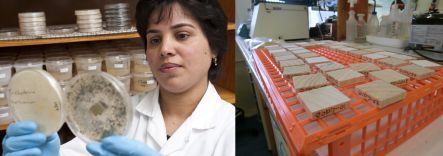
Tripti Singh checks the effectiveness of anti-fungal activity by potential bio-based timber preservatives, initially on agar plates (left) and then on small blocks of wood in the lab (images: Scion)
Almost 90% of New Zealand’s timber plantations are planted in radiata pine, and its wood is widely used in construction, for example for timber framing and cladding in New Zealand houses. However, pine is a soft wood that lacks natural durability and resistance to rot and insect attack, so it must be treated or tantalised before it can be used in situations where it’ll be exposed to the weather or the ground.
Common timber preservatives in use in New Zealand include copper, arsenic, chromium and boron, but there’s growing pressure from both international and local markets to find more environmentally friendly alternatives to the traditional metal-based treatments. Tripti Singh from the Crown Research Institute Scion has been investigating a range of possible bio-based alternatives, and Alison Ballance visits her lab in Rotorua to find out more. The alternatives being investigated have ranged from chilli oil to lavender oil and kiwifruit waste, and chilli oil has made it past the first stage of testing and is now being tested for weathering and durability under field conditions.

